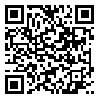Volume 17, Issue 5 (12-2023)
payavard 2023, 17(5): 386-395 |
Back to browse issues page
Download citation:
BibTeX | RIS | EndNote | Medlars | ProCite | Reference Manager | RefWorks
Send citation to:



BibTeX | RIS | EndNote | Medlars | ProCite | Reference Manager | RefWorks
Send citation to:
Talayeh S, Firouzi Jahantigh F, Bahman F. Presenting a Model for Predicting Demand in the Supply Chain of Medical Tourism. payavard 2023; 17 (5) :386-395
URL: http://payavard.tums.ac.ir/article-1-7292-en.html
URL: http://payavard.tums.ac.ir/article-1-7292-en.html
1- Master of Science in Industrial Engineering, Shahid Nikbakht Faculty of Engineering, University of Sistan and Baluchestan, Zahedan, Iran
2- Associate Professor, Department of Industrial Engineering, Shahid Nikbakht Faculty of Engineering, University of Sistan and Baluchestan, Zahedan, Iran ,firouzi@eng.usb.ac.ir
2- Associate Professor, Department of Industrial Engineering, Shahid Nikbakht Faculty of Engineering, University of Sistan and Baluchestan, Zahedan, Iran ,
Abstract: (733 Views)
Background and Aim: The tourism industry plays a very important role in the economic cycle of society. Medical tourism, as one of the types of tourism industries, has a direct result in globalizing health care. Therefore, by strengthening the supply chain in this area, a very high added value can be achieved. For this reason, the present study provides a conceptual framework for predicting the demand for medical tourism supply chain by determining the relationship between medical tourism demand and economic, medical, and welfare-service components of Zahedan city.
Materials and Methods: The present study is a descriptive-analytical and applied research. Data were collected using a questionnaire and field and library methods. The statistical population of interest was specialist doctors in Zahedan city, and 97 people were selected using simple random sampling with Morgan’s table. The validity of the questionnaire was confirmed by experts and its reliability was obtained using Cronbach’s alpha coefficient with SPSS software more than 0.7. Data analysis was performed using the tangent sigmoid neural network algorithm, linear regression criteria, and mean square error. For this purpose, SPSS software was used to examine the correlation between the data, and MATLAB software was used to design the neural network.
Results: There was anerrore in The basis for the optimality of the answers, linear regression criteria and mean square error. The results showed that the values related to regression, education, and health were more than 0.8 and were 0.9033, 0.8818, and 0.9985, respectively. The highest priorities of the respondents related to medical equipment, education, and health were 0.5657, 0.5558, and 0.20726, respectively.
Conclusion: According to the results obtained from the proposed model, the neural network has a high accuracy in predicting the demand for medical tourism supply chain in terms of education, health, and welfare. It is also predicted that the demand for medical tourism has been constant during the one-year period of research and it is expected that medical tourism in Zahedan city will decrease in future. Therefore, it is recommended that officials pay attention to the development and improvement of medical tourism to promote it.
Materials and Methods: The present study is a descriptive-analytical and applied research. Data were collected using a questionnaire and field and library methods. The statistical population of interest was specialist doctors in Zahedan city, and 97 people were selected using simple random sampling with Morgan’s table. The validity of the questionnaire was confirmed by experts and its reliability was obtained using Cronbach’s alpha coefficient with SPSS software more than 0.7. Data analysis was performed using the tangent sigmoid neural network algorithm, linear regression criteria, and mean square error. For this purpose, SPSS software was used to examine the correlation between the data, and MATLAB software was used to design the neural network.
Results: There was anerrore in The basis for the optimality of the answers, linear regression criteria and mean square error. The results showed that the values related to regression, education, and health were more than 0.8 and were 0.9033, 0.8818, and 0.9985, respectively. The highest priorities of the respondents related to medical equipment, education, and health were 0.5657, 0.5558, and 0.20726, respectively.
Conclusion: According to the results obtained from the proposed model, the neural network has a high accuracy in predicting the demand for medical tourism supply chain in terms of education, health, and welfare. It is also predicted that the demand for medical tourism has been constant during the one-year period of research and it is expected that medical tourism in Zahedan city will decrease in future. Therefore, it is recommended that officials pay attention to the development and improvement of medical tourism to promote it.
Keywords: Tourism Supply Chain Management, Medical Tourism, Linear Regression, Mean Square Error, Neural Network
Send email to the article author
| Rights and permissions | |
 |
This work is licensed under a Creative Commons Attribution-NonCommercial 4.0 International License. |





